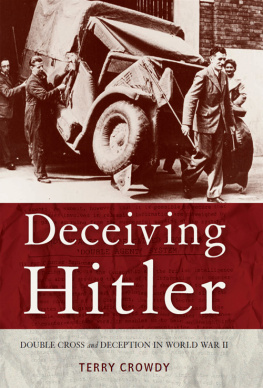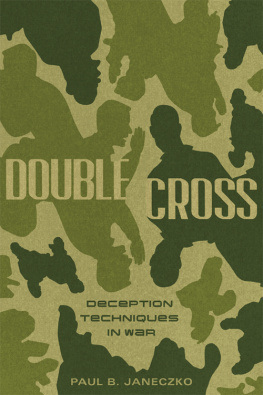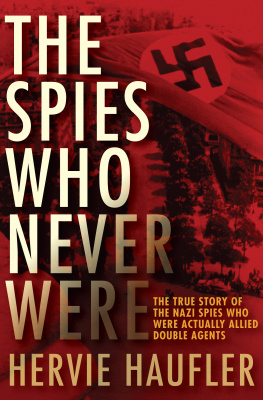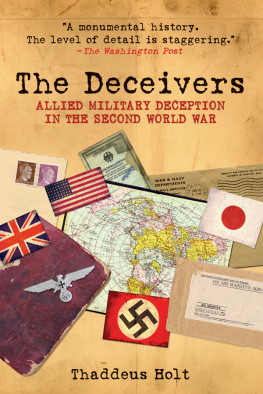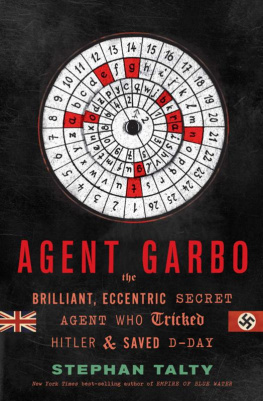DECEIVING HITLER
DOUBLE CROSS AND DECEPTION IN WORLD WAR II
O SPREY
PUBLISHING
DEDICATION
For my father
CONTENTS
ACKNOWLEDGEMENTS
I would like to thank the staff at the National Archives, Kew; the Imperial War Museum, London; the British Library, London; and a special mention for Caroline Herbert at the Churchill Archives Centre, Churchill College, Cambridge. Many thanks for the helpful advice of Richard Stokes, Felix Sefton Delmer, Nigel West, and the late Lieutenant Colonel T. A. Robertson and his family for kindly supplying his photograph. At Osprey I would like to thank Anita Baker, Ruth Sheppard and Venetia Bridges for helping me to realize this project. Last, but by no means least, none of this would have been possible without the kind consideration and eternal patience of my wife, Sarah.
PREFACE
The deceiver by stratagem leaves it to the person himself whom he is deceiving to commit the errors of understanding which at last, flowing into one result, suddenly change the nature of things in his eyes. (von Clausewitz)
W RITING OVER 400 YEARS BEFORE Caesar attempted to invade the British Isles, the legendary ancient Chinese general Sun Tzu pronounced, All warfare is based on deception. Aside from the days of chivalry, when rival heralds would agree a fixed time and place for battle to commence, or when officers invited their opponents to fire first, commanders have often resorted to ruses and devious stratagems to mislead and stupefy their opponents.
During World War II the military deception practised by the Western Allies was so sophisticated it is unlikely to be repeated on the same scale again. Principally a British creation, at the crucial part of the war, when the Allies began the liberation of France, entire German divisions were held back from the fighting or delayed in their arrival because Hitler and his generals had been duped into deploying them elsewhere.
To summarize, the cornerstone of this success was security. In the 1940s Britain was an island with a watchful and vigilant public on high alert. It was not an environment conducive to German spies. Worse still, from the German point of view, the Germans chief spy in Britain at the beginning of the war was also working for the British. Through information provided by this agent British code-breakers were able to break the German secret services codes, which allowed them to be forewarned when new spies were despatched.
Where the British were incredibly smart or perhaps devious would be a better word was in the way that they used the captured agents. Despite a general clamouring to have captured spies executed, wherever possible the spies were kept active and given controlled information to pass back to their masters. This practice was also employed by the British security services in the Middle East with equal success. Before long, there grew a need for organizations that could vet the information passed back by the spies. This was to ensure that nothing operationally vital was accidentally leaked, and to ensure a consistent approach to German intelligence questionnaires.
This led to the establishment of a system of global deception, ensuring the coordination of misinformation provided to the German intelligence services. From Kabul to Lisbon, and Nairobi to Reykjavik, the German intelligence stations were fed a picture entirely of the Allies making, all of which was digested, sent to Berlin and placed before Hitler and his staff. As Nazi High Command pondered and deliberated, the progress of these bogus reports was monitored at the British code-breaking establishment at Bletchley Park. By reading the German intelligence services secret traffic, the deception planners were able to tweak the performances of their best channels. It allowed them to play on the fears of the German High Command, or to endorse the delusions Hitler most wanted to believe.
Of course, there were a number of means by which to deceive the enemy other than through double agents. The first and most obvious was by physical means by the use of camouflage to hide what could be seen, or to make it appear to be something else. This included the creation of dummy installations, vehicles and even ships, which might confuse enemy reconnaissance. There was also the possibility of deceiving ones opponent by emitting false signals traffic, which the enemy Y Service (radio intercept service) would intercept. In much the same way that the ancients would count the campfires of an enemy army, by World War II one could count the number of radios on the air, and, by the urgency of their operation and movement, forecast intentions without necessarily being able to understand the language used. Thus we find dedicated teams of radio operators driving round deserts and the fields of south-east England, reproducing the noise and chatter of colossal phantom armies, which double agents had already led the Nazi hierarchy to believe existed.
The third means of deceiving the enemy was the use of psychological warfare, through what came to be known as Black propaganda. The British conducted a masterly campaign, planting rumours and gossip among the German soldiery and command and even setting up radio stations and newspapers purporting to be the work of the Germans themselves. These factors combined to form a symphony of lies, delivered and orchestrated by the highest and most secret branches of the Allied command structure, ones that few people knew of and even fewer appreciated or understood.
True enough, no one doubts that the liberation of Europe was a result of the fighting men at the sharp end of the conflict. Deception was by no means a guarantor of success, and many cover plans failed to work, went unnoticed, or were completely ignored by the German military and High Command. In many cases, Allied commanders were distrustful of their purpose and suspicious of the practitioners, seeing them as diverting resources away from the real task at hand. However, even in those cases where deception plans gave no tangible benefit, neither did they do any harm.
It is no coincidence that for the Western Allies the biggest turning points in the war against Hitler El Alamein, the Torch landings in North Africa, the invasions of Sicily and Normandy were all backed by elaborate and well-executed cover plans, which were promoted by the double agents. This is not to say that these operations would have failed without them, but victory would almost certainly have come at a much higher price: perhaps even too high a price.
On a personal note, I was introduced to this subject by my father, who did important work during the 1980s in helping to document Kents World War II invasion and anti-aircraft defences. Although principally interested in ack-ack, my father came across an interesting story about how a decoy for Chatham naval base was built on the marshes near the Isle of Sheppey. A man who had worked at the site during the war explained that at night they would use lighting effects to simulate doors opening and closing, and other breaches of the blackout instructions. The Germans would see these pinpricks of light and deduce they were over their target. Once the bombs started to rain down, the operator would ignite large tanks of oil and other flammable material. Water would be sprayed onto the fires to create large plumes of steam, and give German pilots the impression that firemen were trying to extinguish the blaze. Adding to my fascination with this ruse, my father then told me about a double agent called Garbo who tricked the Germans into thinking the D-Day invasion was due to arrive at Calais rather than Normandy. After several years of research I know that this story was just the tip of the iceberg. I have remained fascinated by this subject ever since, and hope this work will help introduce others to the world of double cross and deception during World War II.

